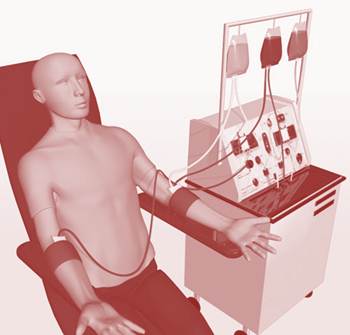Apheresis has more stem cells than bone marrow?
Does a blood stem cell collection beat a marrow stem cell collection? I often get asked by pateints to explain the claims of stem cell clinics. This is sometimes difficult, as many times clinics that treat every known disease make some nonsensical claims. This is an example of one of those requests. A patient contacted me that a central American clinic was claiming that their apheresis stem cell process produced more stem cells that any of the Regenexx bone marrow aspiration processes. The first thing I did was to go on-line to check what they were doing. They perform peripheral blood apheresis, a process that takes the blood and tries to filter it’s cells based on size/weight, throwing off a small fraction for collection while the rest goes back into the patient. So the first issue is that the process itself is a very inexact technology that was designed to at best isolate all cells of certain densities, but not concentrate stem cells. If stem cells are in the fraction they chose to pull off, they are some very tiny fraction of the collection. This brings up the second issue, stem cells are very, very rare in the blood. They are there, but at a tiny fraction of their number that live in the bone marrow. This is because the major stem cell reservoir for the blood is the bone marrow. This is in fact how stem cells were discovered. Scientists many years ago were able to keep mice alive after they had been irradiated to kill their own marrow by transplanting the marrow of another mouse. This eventually became known as a bone marrow transplant. There’s a reason it’s not known as a blood transplant, as there simply aren’t enough stem cells in the blood to make a go of it repopulating all the stem cells killed by radiation. Finally, I have had direct experience with a stem cell collection using G-CSF mobilized blood collected through apheresis. In this case, a powerful drug was used to kick out as many stem cells as possible into the peripheral blood from the marrow (G-CSF) and they were then pulled off. Despite our best efforts, we were never able to find many viable stem cells in these collections, let alone anywhere near the number found in marrow. The upshot? The claim that apheresis produces more stem cells than a direct bone marrow draw isn’t accurate. There is simply no rationale for apheresis for blood stem cell collection when a simple and minimally invasive bone marrow aspiration will always collect far more stem cells than a machine hooked to your blood supply.

NOTE: This blog post provides general information to help the reader better understand regenerative medicine, musculoskeletal health, and related subjects. All content provided in this blog, website, or any linked materials, including text, graphics, images, patient profiles, outcomes, and information, are not intended and should not be considered or used as a substitute for medical advice, diagnosis, or treatment. Please always consult with a professional and certified healthcare provider to discuss if a treatment is right for you.

